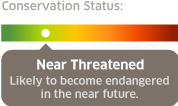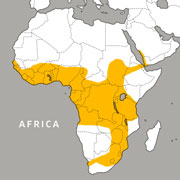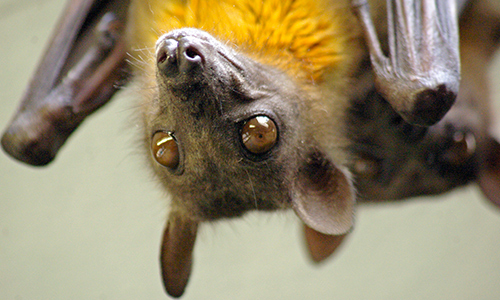Appearance:
These bats can range in color from pale yellow to dark brownish-grey. They get their name from the yellow or straw-colored fur around the neck. Their wings are long and narrow, allowing them to fly long distances and not expend too much energy by flapping a lot.
Size:
- Length: 5-8 inches, with a wingspan of up to 30 inches
- Weight: 8-12 ounces
Diet:
Fruit, seeds, nectar and flowers
These bats can eat up to twice their body weight a day in fruit.
Reproduction:
Male bats reach sexual maturity at 12 months, and females at 2 years of age. Mating season is late spring, April to June. The developing embryo undergoes delayed implantation, where the embryo implants in the uterus but remains dormant until its development resumes again, usually around October. This is so the birth coincides with the start of the wettest season and the most amount of fruit is available. Most all births (one per year) produce a single offspring, and twins are rare.
Gestation:
The gestation period typically lasts nine months, but the embryo only takes four months to develop. Without delayed implantation, births occur just four months after mating.
Behavior:
This species is nocturnal, roosting in tall trees during the day and flying at night in search of fruit. These bats roost in social groups ranging in size from 100,000 to 1,000,000. They may be active during the day as they move around the roost. During roosting, bats spend a lot of time grooming themselves, hanging with one foot and using the other to groom their entire body. They show "roost-site fidelity," which means they return to the same roost sites over time. At night, the bats will alternate between feeding and resting from sunset to sunrise.
These bats fly in straight lines and at higher altitudes than other species of fruit bats.
Straw-colored fruit bats don't echolocate. Roosts are loud, with lots of chatter throughout the day. Grooming is important both in courtship and in the care of young. Pups will form lasting bonds with other pups born within the maternity colony and will maintain those bonds outside after leaving them.
Role in their habitat:
Their diet is primarily frugivorous (feeding on fruit), although they don't eat the fruit itself. They suck the fruit juice from the pulp and spit out the pulp. Because they eat fruit and flowers, bats play an important role in pollination and seed dispersal of the forests.
Habitat/range:
These bats are widespread through Africa as well as the southwest Arabian Peninsula. This includes several islands off the African coast, like Madagascar. Their primary habitat is tropical forests where food is plentiful. These bats typically roost in tall trees but have been found in caves. They will annually migrate up to 2,000 miles.
Median life expectancy:
15-20 years
Threats in wild:
Straw-colored fruit bats are currently common and widespread, although deforestation and hunting are beginning to cause significant declines in some areas of their range. In West and Central Africa, they are heavily harvested for the bushmeat trade.
Conservation:
This species lives in a number of protected areas, including a large roosting colony found in Kasanka National Park in Zambia; only a small part of the migratory route to and from this park is protected. The identification and protection of roosting sites and migratory patterns will play an important role in conservation efforts.
You can help!
Bats are important to many eco-systems, including ones local to Boston. Educate yourself and your friends/family about bats to end the stigma behind them. You can even build/purchase bat boxes to encourage local bats to roost near you!
Fun facts:
- The straw-colored fruit bat is the second largest bat in Africa. Like other fruit bats, this bat does not use echolocation.
- These bats have been observed chewing soft wood, which they do to obtain water.




